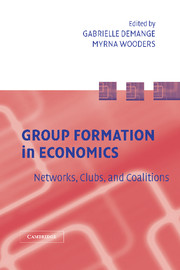Book contents
- Frontmatter
- Contents
- List of Contributors
- Introduction
- PART ONE NETWORK FORMATION, COMMUNICATION, AND LEARNING
- 1 A Survey of Network Formation Models: Stability and Efficiency
- 2 Models of Network Formation in Cooperative Games
- 3 Farsighted Stability in Network Formation
- 4 Learning in Networks
- PART TWO ON EQUILIBRIUM FORMATION OF GROUPS: A THEORETICAL ASSESSMENT
- PART THREE GROUPS, CLUBS, ALLIANCES IN POLITICAL AND ECONOMIC ENVIRONMENTS
- Index
4 - Learning in Networks
Published online by Cambridge University Press: 02 February 2010
- Frontmatter
- Contents
- List of Contributors
- Introduction
- PART ONE NETWORK FORMATION, COMMUNICATION, AND LEARNING
- 1 A Survey of Network Formation Models: Stability and Efficiency
- 2 Models of Network Formation in Cooperative Games
- 3 Farsighted Stability in Network Formation
- 4 Learning in Networks
- PART TWO ON EQUILIBRIUM FORMATION OF GROUPS: A THEORETICAL ASSESSMENT
- PART THREE GROUPS, CLUBS, ALLIANCES IN POLITICAL AND ECONOMIC ENVIRONMENTS
- Index
Summary
Introduction
In a wide range of economic situations, individuals make decisions without being fully informed about the rewards from different options. In many of these instances the decision problems are recurrent, and it is natural that individuals use their past experience and the experience of others in making current decisions. The experience of others is important for two reasons:
It may yield information on different actions per se (as in the case of the choice of new consumer products, agricultural practices, or medicines prescribed).
In many settings the rewards from an action depend on the choices made by others, and so there is a direct value to knowing about other's actions (as in the case of which credit card to use, which language to learn, or whether to buy a fax machine).
This suggests that the precise way in which individuals interact can influence the generation and dissemination of useful information and that this could shape individual choices and social outcomes. In recent years, these considerations have motivated a substantial body of work on learning in economics, which takes explicit account of the structure of interaction among individual entities. The present chapter provides a survey of this research.
I will consider the following simple framework: there is a set of individuals located on nodes of a network, and the arcs of the network reflect relations between these individuals.
- Type
- Chapter
- Information
- Group Formation in EconomicsNetworks, Clubs, and Coalitions, pp. 122 - 168Publisher: Cambridge University PressPrint publication year: 2005
- 31
- Cited by

